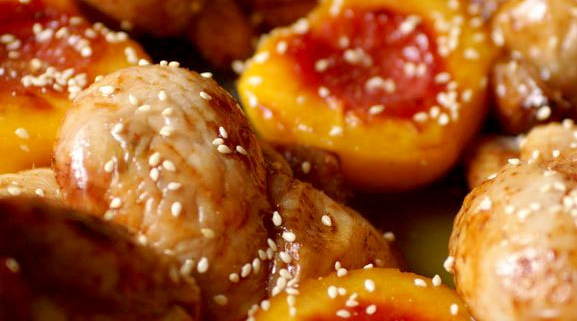Cockerel with chestnut honey and peaches
Something that I loved about Dominique‘s cooking was her use of fruit in salads and meat dishes. It has always come naturally to me to throw fruit into a salad – raspberries with asparagus, figs with feta cheese, blood oranges with beets – yet in France this makes me something of an eccentric. Since the end of the Renaissance fruit has barely featured in French cuisine, but for a few exceptions: a spoonful of onion or fig jam next to foie gras, cherry preserves as a foil for Basque ewe’s milk cheese, melon wrapped in cured ham (an Italian rather than a French brainwave as far as I know). Today things are finally changing, thanks in part to the influence of Moroccan cuisine with its fruit-laced and honey-sweetened tagines. British-style chutneys are also making inroads – an apricot and chili pepper version that I picked up in the Cévennes is sensational with the local goat’s cheese, pélardon.
This dish from Dominique has a definite Moroccan touch, even if it relies on intense and slightly bitter-tasting chesnut honey for its character rather than any spices. She also finishes it off in a uniquely French – or perhaps Belgian – way, with plenty of butter and a little crème fraîche to bind the sauce. What I especially like is its adaptability: you could replace the cockerel with chicken, guinea fowl or duck and substitute nectarines, apricots, figs, apples or pears for the peaches. If you don’t like rich sauces, you could reduce the amount of butter or even leave it out completely. (I’ve gone easy on the butter in my version of this recipe: I remember the chefs at the Cordon Bleu blithely finishing just about any sauce with a half-pound packet of butter.) Another deep-colored honey with plenty of personality could stand in for chestnut honey, which is produced in regions such as the Ardèche, the Cévennes, Corsica and Provence.
You can make this dish entirely ahead of time, just warming the cockerel and peaches in the oven and gently heating the sauce before serving.
Cockerel with chestnut honey and peaches
Serves 4
2 cockerels, whole
Sea salt and freshly ground pepper
2 tbsp chestnut honey
4 tbsp butter
4 peaches
1 tbsp balsamic vinegar
1 tbsp crème fraîche or whipping cream
Toasted sesame seeds, for garnish.
Preheat the oven to 375 F (180 C), on the convection setting if possible. Season the cockerels well with salt and pepper. In a small saucepan, melt together 1 tbsp each chestnut honey and butter. Brush this over the cockerels and place in the hot oven. Roast for about 50 mins, basting a couple of times and checking to see that the juices are not burning.
Remove the cockerels from the oven, set aside the birds and strain the juices into a bowl. Place the juices in the refrigerator until the fat solidifies, then discard the fat. (If you don’t have time for this, just spoon the fat off carefully from the surface of the juices.)
Half-fill a medium saucepan with water and bring to a boil. Dip in the peaches for about 15-20 seconds to loosen their skins. Rinse with cold water, then cut the peaches in half, remove the stones and peel each half.
Heat another 1 tbsp each chestnut honey and butter in a large nonstick frying pan over high heat. Add the peaches, stone side down and cook until lightly browned, adjusting the heat so that the juices don’t burn. Flip them over and cook for about 1 min on the other side. Deglaze the pan juices with the balsamic vinegar, then strain the juice and mix it with the meat juices in a small saucepan.
Reduce these juices until they are slightly syrupy, then add the remaining butter, cold from the refrigerator, in small chunks, whisking all the time. When the sauce is glossy and emulsified, whisk in the crème fraîche.
Before serving, cut the cockerels in half and arrange on an ovenproof serving dish with the peaches. Warm through in the oven and sprinkle with toasted sesame seeds. Serve the meat and peaches with the sauce on the side, as it could separate if heated with the meat in the oven.




Fiona, because a cockerel is a small bird it’s actually very tender. Have fun with this recipe and don’t be afraid to play around with other poultry or fruits!
I will be trying this recipe for sure. I have never tasted cockerel so am looking forward to another new taste. I always thought that Cockerel would be a tuff meat, we will see!!
Ciao Diva! I think I just couldn’t bring myself to say that a cockerel is a baby rooster. In Canada we used to buy Cornish game hens – I’m not sure if these are still available, but they are about the same size. A small chicken would do fine, perhaps cut into four instead of in half.
Ciao bella.. for those American speaking readers, what is a cockerel?
small chicken?
Indeed it should be perfect, Martha! I love the thought of this recipe being reproduced on your island.
That reads like something fabulous. I will definitely try it this autumn. As I work in the local organic restaurant, Mahe Köök, I have access to organic honey which should be perfect for the recipe.